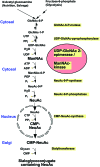Sialylation is essential for early development in mice
- PMID: 11929971
- PMCID: PMC122758
- DOI: 10.1073/pnas.072066199
Sialylation is essential for early development in mice
Abstract
Sialic acids are widely expressed as terminal carbohydrates on glycoconjugates of eukaryotic cells. Sialylation is crucial for a variety of cellular functions, such as cell adhesion or signal recognition, and regulates the biological stability of glycoproteins. The key enzyme of sialic acid biosynthesis is the bifunctional UDP-N-acetylglucosamine-2-epimerase/N-acetylmannosamine kinase (UDP-GlcNAc 2-epimerase), which catalyzes the first two steps of sialic acid biosynthesis in the cytosol. We report that inactivation of the UDP-GlcNAc 2-epimerase by gene targeting causes early embryonic lethality in mice, thereby emphasizing the fundamental role of this bifunctional enzyme and sialylation during development. The need of UDP-GlcNAc 2-epimerase for a defined sialylation process is exemplified with the polysialylation of the neural cell adhesion molecule in embryonic stem cells.
Figures





References
Publication types
MeSH terms
Substances
LinkOut - more resources
Full Text Sources
Other Literature Sources
Molecular Biology Databases

